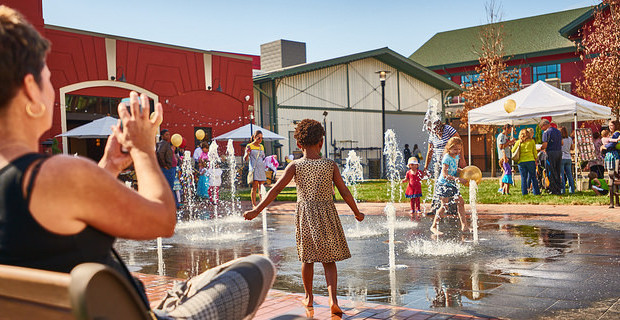
What’s Next For Commercial Real Estate Marketing?
By: Mark Winter
This article was originally published by Chain Store Age.
The commercial real estate community is somewhat of a paradox. For an industry that is literally built on the premise of creating new and exciting destinations, there is a tendency to do things the way they have always been done.
That limiting mindset is perhaps most noticeable with respect to marketing and branding, where far too many real estate leaders have their feet firmly planted in the past. Marketing resources and their corresponding measurement tools have advanced radically in the last few years, yet the industry in general has been slow to evolve and embrace this great opportunity.
Progressive marketing programs leverage the latest engagement platforms and innovative strategies that are proven to effectively connect and communicate with clearly defined target audiences. They not only disseminate strategic messaging, they also create and sustain relationships, gather information, foster engagement and integrate into the experiential fabric of the physical environments themselves.
Gaining greater awareness of these powerful tools and tactics and understanding just how profound of an opportunity exists is the first step. In an effort to see the future, we must first take a look at the past.
The billboard effect
One way to get a sense of the costs and consequences of marketing inertia is by looking at one of the oldest and most familiar marketing tools still in use today: the billboard. Billboards were a marketing and advertising phenomenon in the middle of the 20th Century, coming to prominence alongside the expanding interstate highway system. In the media environment of today, however, they are an anachronism: how can someone read a billboard when they are looking down and scrolling through their phones? Billboards are the realm of product liability attorneys or fast food restaurants on the interstate. And yet some developers spend thousands of dollars a month trying to get people’s attention through this relatively expensive, inefficient and outdated channel. The lesson here is that delivering new messages with the same old tools is not a winning formula.
Site plans
At least half of developer/project websites today are not responsive. Many are built primarily for desktop users, yet more than half of people viewing them are doing so through mobile platforms like smartphones and tablets.
Beyond the foundational functionality, the content of the website itself needs to be dynamic. A retail or mixed-use website used to be no more than an “online brochure.” Many had little more than a list of stores, some pretty pictures and some basic contact information. A decade ago, that was enough. Today, however, if your site serves as a digital business card, you are doing a huge disservice to both your guests and your tenants. The best websites are engaging and interactive, providing evolving and timely content and new ways to connect and communicate with consumers. Blogs, contests, integrated social and review channels, virtual tours and other specialized content are designed to provide real value to users and to promote deeper engagement. Perhaps most importantly, they have the ability to not just capture their attention, but also their information — new tools make it possible to track and analyze valuable information about users who come to the site. That data is an important ingredient in an effective and impactful modern marketing program.
Data makes us smarter (and more successful)
How do you review performance and measure success? In commercial real estate development, developers and owners are intimately familiar with everything from the basics like location and demographics, to key financial and operational metrics that track a center’s performance. It is surprising that professionals who are so focused on the metrics and numbers surrounding their projects and/or portfolio are not nearly as data-driven when it comes to assessing the performance of their project’s marketing programs. That disconnect is even more eye-opening given the fact that there are so many sophisticated new tools and tactics available today to gather that data.
Animation and activation
Just as the consumer’s ability to gather information and make purchases is greatly enhanced in today’s tech-driven marketplace, our ability to track and connect with target audiences has never been better. It is much easier and more effective (not to mention more cost-effective) to connect through social channels and other new media. Fundamentally, social engagement through various new media platforms is an exchange: it creates a relationship dynamic—back and forth.
Beyond that, extraordinary opportunities are emerging not in virtual space, but in real space … in the centers themselves. The goal is to utilize these digital marketing tools to animate a project and enable guests to engage with the center itself through things like live tweeting, on-site Instagram feeds and live-streaming special events. Utilizing technology while at the center connects what is going on in the digital space with what is going on in the physical space.
Calibrated for success
The traditional marketing conundrum has always been that it can be challenging to definitively measure ROI. You can measure marketing success. In fact you must if you want to unlock the power and potential. It sounds elementary, but most companies fail to set clearly defined and measurable goals for their marketing programs. Remember, if you cannot define it, you cannot measure it. If you cannot measure it, how can you hold your marketing team accountable? When the stars are aligned properly, owners, investors and partners will have access to comprehensive reporting on an ongoing basis. That reporting should paint a clear and detailed picture based on specific metrics that will either be on track or off track. Great programs are recalibrated often — the digital space moves quickly and needs to be monitored, analyzed and adjusted in real time. Messages can trend with content that is relevant that week, that day, that hour.
In a world that is moving at light speed, accountability is critical. If you are not holding your marketing program accountable to going beyond the “maintenance” of your marketing footprint by leveraging outside resources and tools, you are almost certainly missing an opportunity.
The way forward
The result of all this is that real estate developers today have the ability to connect on a much deeper level with customers through true two-way communication, where your fans become your brand ambassadors. Proceed with caution, however. Just because someone knows what Twitter and Instagram are does not mean that they should be running your marketing department. This is equal parts art and science.
Real estate developers understand that a great master plan is much more than a series of individual buildings. There is a cohesive and complementary nature to the layout of a compelling commercial or mixed-use space, where everything flows and works together, and the whole is greater than the sum of its parts. True marketing artists will design programs and strategies that connect in a similar manner. When done correctly, such a strategy promotes clarity, efficiency and, most importantly, meaningful and measurable results.
Finally, recognize this as an opportunity — not a threat. Capitalizing on that opportunity means making a commitment. Great marketing programs are built as operating machines, not transactions. Whether it is your social program, website or other marketing tactic, it will require care and nurturing. The investment in the tool itself is the cost to get in the game. You must be prepared to deploy the necessary financial and human resources to optimize and actualize that investment. Early, thoughtful adopters have been, and will continue to be rewarded. For the rest, enjoy those billboards.
Looking for more insight? Download our free e-book on why media matters for mixed-use real estate projects.




